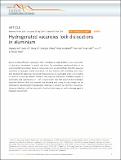| dc.contributor.author | Xie, Degang | |
| dc.contributor.author | Li, Suzhi | |
| dc.contributor.author | Li, Meng | |
| dc.contributor.author | Wang, Zhangjie | |
| dc.contributor.author | Gumbsch, Peter | |
| dc.contributor.author | Ma, Evan | |
| dc.contributor.author | Li, Ju | |
| dc.contributor.author | Shan, Zhiwei | |
| dc.contributor.author | Sun, Jun, 1975- | |
| dc.date.accessioned | 2017-04-04T15:17:06Z | |
| dc.date.available | 2017-04-04T15:17:06Z | |
| dc.date.issued | 2016-11 | |
| dc.date.submitted | 2016-02 | |
| dc.identifier.issn | 2041-1723 | |
| dc.identifier.uri | http://hdl.handle.net/1721.1/107837 | |
| dc.description.abstract | Due to its high diffusivity, hydrogen is often considered a weak inhibitor or even a promoter of dislocation movements in metals and alloys. By quantitative mechanical tests in an environmental transmission electron microscope, here we demonstrate that after exposing aluminium to hydrogen, mobile dislocations can lose mobility, with activating stress more than doubled. On degassing, the locked dislocations can be reactivated under cyclic loading to move in a stick-slip manner. However, relocking the dislocations thereafter requires a surprisingly long waiting time of ∼10[superscript 3] s, much longer than that expected from hydrogen interstitial diffusion. Both the observed slow relocking and strong locking strength can be attributed to superabundant hydrogenated vacancies, verified by our atomistic calculations. Vacancies therefore could be a key plastic flow localization agent as well as damage agent in hydrogen environment. | en_US |
| dc.language.iso | en_US | |
| dc.publisher | Nature Publishing Group | en_US |
| dc.relation.isversionof | http://dx.doi.org/10.1038/ncomms13341 | en_US |
| dc.rights | Creative Commons Attribution 4.0 International License | en_US |
| dc.rights.uri | http://creativecommons.org/licenses/by/4.0/ | en_US |
| dc.source | Nature | en_US |
| dc.title | Hydrogenated vacancies lock dislocations in aluminium | en_US |
| dc.type | Article | en_US |
| dc.identifier.citation | Xie, Degang, Suzhi Li, Meng Li, Zhangjie Wang, Peter Gumbsch, Jun Sun, Evan Ma, Ju Li, and Zhiwei Shan. “Hydrogenated Vacancies Lock Dislocations in Aluminium.” Nature Communications 7 (November 3, 2016): 13341. | en_US |
| dc.contributor.department | Massachusetts Institute of Technology. Department of Nuclear Science and Engineering | en_US |
| dc.contributor.mitauthor | Xie, Degang | |
| dc.contributor.mitauthor | Li, Suzhi | |
| dc.contributor.mitauthor | Li, Ju | |
| dc.relation.journal | Nature Communications | en_US |
| dc.eprint.version | Final published version | en_US |
| dc.type.uri | http://purl.org/eprint/type/JournalArticle | en_US |
| eprint.status | http://purl.org/eprint/status/PeerReviewed | en_US |
| dspace.orderedauthors | Xie, Degang; Li, Suzhi; Li, Meng; Wang, Zhangjie; Gumbsch, Peter; Sun, Jun; Ma, Evan; Li, Ju; Shan, Zhiwei | en_US |
| dspace.embargo.terms | N | en_US |
| dc.identifier.orcid | https://orcid.org/0000-0002-7841-8058 | |
| mit.license | PUBLISHER_CC | en_US |
